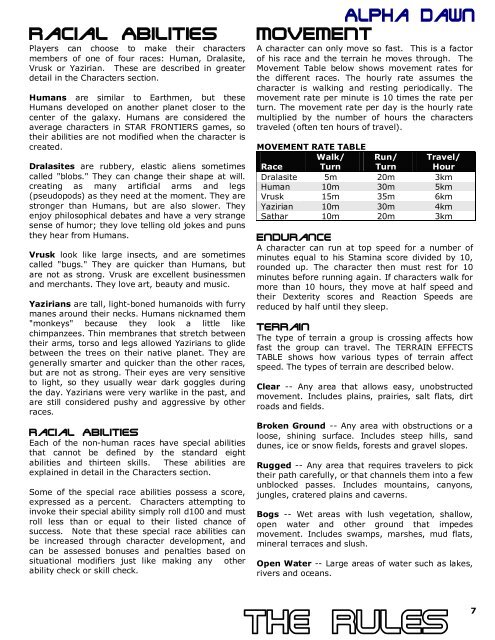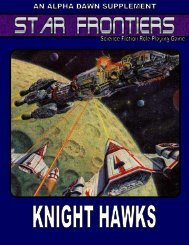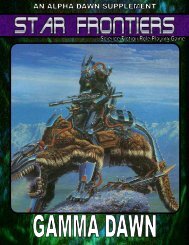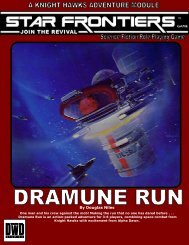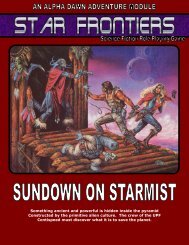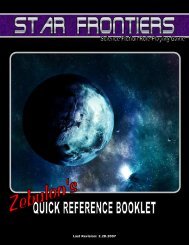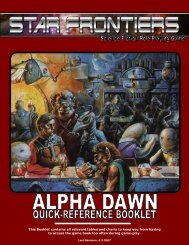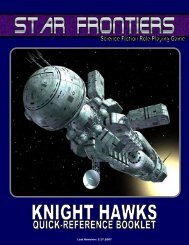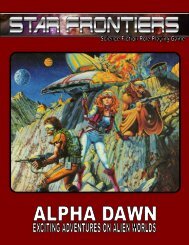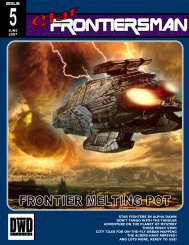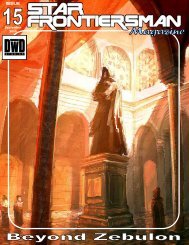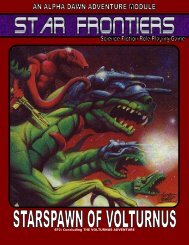Alpha Dawn - Star Frontiersman
Alpha Dawn - Star Frontiersman
Alpha Dawn - Star Frontiersman
Create successful ePaper yourself
Turn your PDF publications into a flip-book with our unique Google optimized e-Paper software.
Racial Abilities<br />
Players can choose to make their characters<br />
members of one of four races: Human, Dralasite,<br />
Vrusk or Yazirian. These are described in greater<br />
detail in the Characters section.<br />
Humans are similar to Earthmen, but these<br />
Humans developed on another planet closer to the<br />
center of the galaxy. Humans are considered the<br />
average characters in STAR FRONTIERS games, so<br />
their abilities are not modified when the character is<br />
created.<br />
Dralasites are rubbery, elastic aliens sometimes<br />
called "blobs." They can change their shape at will.<br />
creating as many artificial arms and legs<br />
(pseudopods) as they need at the moment. They are<br />
stronger than Humans, but are also slower. They<br />
enjoy philosophical debates and have a very strange<br />
sense of humor; they love telling old jokes and puns<br />
they hear from Humans.<br />
Vrusk look like large insects, and are sometimes<br />
called "bugs." They are quicker than Humans, but<br />
are not as strong. Vrusk are excellent businessmen<br />
and merchants. They love art, beauty and music.<br />
Yazirians are tall, light-boned humanoids with furry<br />
manes around their necks. Humans nicknamed them<br />
"monkeys" because they look a little like<br />
chimpanzees. Thin membranes that stretch between<br />
their arms, torso and legs allowed Yazirians to glide<br />
between the trees on their native planet. They are<br />
generally smarter and quicker than the other races,<br />
but are not as strong. Their eyes are very sensitive<br />
to light, so they usually wear dark goggles during<br />
the day. Yazirians were very warlike in the past, and<br />
are still considered pushy and aggressive by other<br />
races.<br />
Racial Abilities<br />
Each of the non-human races have special abilities<br />
that cannot be defined by the standard eight<br />
abilities and thirteen skills. These abilities are<br />
explained in detail in the Characters section.<br />
Some of the special race abilities possess a score,<br />
expressed as a percent. Characters attempting to<br />
invoke their special ability simply roll d100 and must<br />
roll less than or equal to their listed chance of<br />
success. Note that these special race abilities can<br />
be increased through character development, and<br />
can be assessed bonuses and penalties based on<br />
situational modifiers just like making any other<br />
ability check or skill check.<br />
MOVEMENT<br />
A character can only move so fast. This is a factor<br />
of his race and the terrain he moves through. The<br />
Movement Table below shows movement rates for<br />
the different races. The hourly rate assumes the<br />
character is walking and resting periodically. The<br />
movement rate per minute is 10 times the rate per<br />
turn. The movement rate per day is the hourly rate<br />
multiplied by the number of hours the characters<br />
traveled (often ten hours of travel).<br />
MOVEMENT RATE TABLE<br />
Walk/ Run/ Travel/<br />
Race Turn Turn Hour<br />
Dralasite 5m 20m 3km<br />
Human 10m 30m 5km<br />
Vrusk 15m 35m 6km<br />
Yazirian 10m 30m 4km<br />
Sathar 10m 20m 3km<br />
Endurance<br />
A character can run at top speed for a number of<br />
minutes equal to his Stamina score divided by 10,<br />
rounded up. The character then must rest for 10<br />
minutes before running again. If characters walk for<br />
more than 10 hours, they move at half speed and<br />
their Dexterity scores and Reaction Speeds are<br />
reduced by half until they sleep.<br />
Terrain<br />
The type of terrain a group is crossing affects how<br />
fast the group can travel. The TERRAIN EFFECTS<br />
TABLE shows how various types of terrain affect<br />
speed. The types of terrain are described below.<br />
Clear -- Any area that allows easy, unobstructed<br />
movement. Includes plains, prairies, salt flats, dirt<br />
roads and fields.<br />
Broken Ground -- Any area with obstructions or a<br />
loose, shining surface. Includes steep hills, sand<br />
dunes, ice or snow fields, forests and gravel slopes.<br />
Rugged -- Any area that requires travelers to pick<br />
their path carefully, or that channels them into a few<br />
unblocked passes. Includes mountains, canyons,<br />
jungles, cratered plains and caverns.<br />
Bogs -- Wet areas with lush vegetation, shallow,<br />
open water and other ground that impedes<br />
movement. Includes swamps, marshes, mud flats,<br />
mineral terraces and slush.<br />
Open Water -- Large areas of water such as lakes,<br />
rivers and oceans.<br />
7


